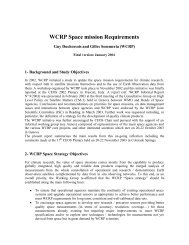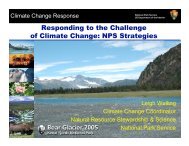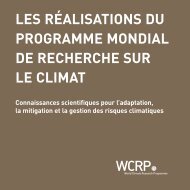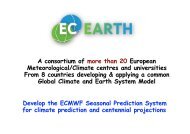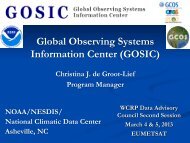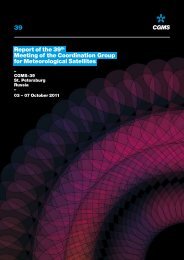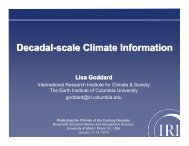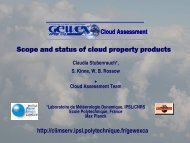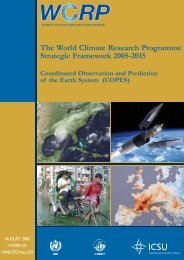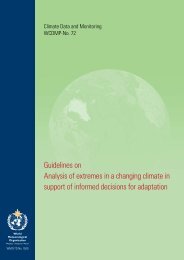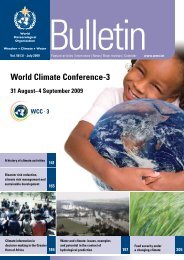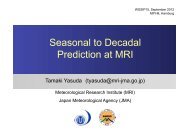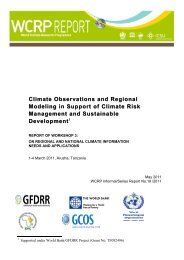OCHAMP-2012.pdf
OCHAMP-2012.pdf
OCHAMP-2012.pdf
Create successful ePaper yourself
Turn your PDF publications into a flip-book with our unique Google optimized e-Paper software.
Opportunities and Challenges in<br />
Monsoon Prediction in a Changing<br />
Climate:(<strong>OCHAMP</strong>-2012)<br />
A Report<br />
B.N.Goswami<br />
Indian Institute of Tropical Meteorology (IITM), Pune
Outline<br />
v Background of the Conference :<br />
IITMs Golden Jubilee<br />
v Conference Statistics<br />
v Highlights of the Conference<br />
v Summary of the Panel Discussion
Background<br />
v As a part of celebration of Golden Jubilee Year<br />
(1962-2012) of IITM a conference on<br />
Opportunities and Challenges of Monsoon<br />
Prediction in a Changing Climate<br />
(<strong>OCHAMP</strong>-2012) was proposed by IITM<br />
during 21-25 February, 2012.<br />
v Strong support from WCRP/WWRP made the<br />
Conference truly International !<br />
v With support from Ministry of Earth Sciences<br />
(MoES), Govt. India and ICTP, Trieste, we<br />
added a Training component by inviting a large<br />
number Ph.D students and early career<br />
scientists to interact with the Experts.
Inauguration of <strong>OCHAMP</strong> by<br />
WMO Secretary General
Participants
At the Third Session of WMO Congress in May 1959<br />
following Resolution was adopted:<br />
Resolution 22 (CG-II)<br />
Research Institute for Tropical Meteorology<br />
The Congress, considering,<br />
(1) The urgent need for research work in tropical<br />
Meteorology especially as regards developing<br />
forecasting techniques,<br />
(2) The limited facilities and resources available in<br />
tropical countries for carrying out search,<br />
(3) The great economic value of improved Met.<br />
Services in the tropics for public transport, agriculture,<br />
public health, water resource development and many<br />
other branches of the national economy,<br />
DECIDES that the World Met. Organization should do<br />
everything possible to initiate, sponsor and encourage<br />
the establishment and operation of one or more<br />
research institute for tropical meteorology &<br />
DECIDES the Executive Committee to take<br />
all possible steps to implement the above<br />
decision<br />
Proposal for the Institute<br />
of Tropical Meteorology<br />
Resolution 22 (CG-II) adopted at the<br />
Third Session of the WMO Congress<br />
From <br />
No.B86400 <br />
India Meteorological Department <br />
The Director General of Observatories <br />
Lodi Road, New Delhi. <br />
To <br />
The Secretary to the Government of India, <br />
Ministry of Transport and Communications <br />
Department of Communications & Civil Aviation) <br />
New Delhi. <br />
Dated New Delhi, the 9 th June 1961 <br />
Subject:-‐ Third Five Year Plan – Development of Research <br />
Organization: INSTITUTE OF TROPICAL METEOROLOGY, <br />
SMALL RESEARCH UNITS AT REGIONAL CENTRES. <br />
Sir, <br />
I have the honour to forward herewith proposals concerning scheme <br />
No.12 “Development of Research Organization: Institute of Tropical Meteo-‐ <br />
rology, Small Research Units at Regional Centres” included in the third <br />
Five Year Plan of the department, for administrative approval of Govern-‐ <br />
ment. The justifications for the scheme together with details of the <br />
phased programme are given below:-‐ <br />
A. INSTITUTE OF TROPICAL METEOROLOGY <br />
1. Need for a meteorological research Institute. Ever since its <br />
inception in 1875, the India Meteorological Department has been engaged <br />
in the study of meteorology as a science in addition to rendering service <br />
to various interests who require meteorological information and advice and <br />
warnings. In the years upto 1940, departmental officers, though few in <br />
number, could spend a fair part of their time in research work connected <br />
with the synoptic, climatological and physical aspects of the atmosphere <br />
and make significant contributions to the science of meteorology. The <br />
increase in knowledge of the characteristics and behaviour of the atmos-‐ <br />
phere over India derived from such research work was applied to improve <br />
the technical service to various interests including shipping, aviation <br />
and the public. <br />
With the rapid development of transport and communications over <br />
land, sea and air, and more particularly in the air, demands for met. <br />
service have increased considerably during the last 20 years and more <br />
specially in the last 5 to 10 years. Though a large addition to the <br />
strength of the department has taken place in the last 20 years, most of <br />
the time officers and staff is spent in rendering service to various <br />
.. 2
Birth of the Institute<br />
v IMD received the formal approval of the Govt.<br />
of India in February 1962 as one of the schemes<br />
under the Third Five Year Plan.<br />
v The Institute was formally established on 17 th<br />
November 1962 with the posting of Prof. P.R.<br />
Pisharoty as its Director.<br />
v The ITM was established as a distinct unit of<br />
the India Meteorological Department for<br />
research in Meteorology and Atmospheric<br />
Science.<br />
v ITM started functioning in Ramdurg House, a<br />
building of IMD adjacent to its main office.
IITM in Ramdurg House
Seminar Verandah
SHISHIR: CCCR<br />
Housing Complex<br />
HPC Building
Seminar Halls and Training Facility<br />
Varahmihir Hall<br />
Pishroty Hall<br />
Aryabhatta hall<br />
New Training Hall
e Doppler Wind Radar<br />
is a type of weather observing equipment that uses<br />
radar or sound waves (SODAR) to detect the wind<br />
speed and direction at various elevations above the<br />
ground<br />
Mobile Doppler<br />
HPC with peak performance 70TF<br />
LIDAR Profiler<br />
Mobile X-Band Doppler<br />
Dual Polarized Radar<br />
Microwave<br />
Radiometer Profiler
No. of Scientists remains roughly<br />
constant
New Initiatives<br />
Centre for Advanced Training in Earth System<br />
Science and Climate (CAT-ESSC)<br />
v To attract good students for doing Ph.D in<br />
Climate Science, a Job-linked Training Program.<br />
v 20-30 Trainees every year will be inducted to<br />
jobs in different MoES organizations after going<br />
through a 3 Semester Training. Continue to do<br />
Ph.D while on job.<br />
v 2 nd Batch has just been selected<br />
v We are happy to see that some very good<br />
students are attracted
New Initiatives<br />
The Monsoon Mission<br />
v Mission mode project to deliver quantifiable<br />
improvement in skill of prediction of monsoon on<br />
short, medium and seasonal time scale.<br />
v Build partnership with academic and R & D<br />
organizations to work on improving skill of<br />
Operational Modeling Systems<br />
v A five year project. Govt. has allocated about $80<br />
million to the project, about 50% of which will be<br />
available for funding projects<br />
v Open to International Partners as well!
Conference Statistics<br />
v Total number of Plenary Sessions:7<br />
v Exclusive time for Posters in each Session<br />
v Total no. of Participants: 340<br />
v Oral Presentations: 57<br />
v Poster Presentations: 235<br />
v No. of Graduate Students/ Early Career<br />
Scientists attended: 150<br />
v Participants from outside India: 58
Major Opportunities: Prediction and<br />
Predictability of Monsoon<br />
v Prediction and Predictability of Monsoon:<br />
v The skill of coupled O-A models for predicting<br />
ISMR has become equal to or better than<br />
statistical models in recent years (Shukla /<br />
Goswami) <br />
v Predictions of high-frequency extreme events<br />
show skill and sufficient lead to for utility<br />
(Webster)<br />
v Reliable skill of Monsoon ISOs from coupled O-<br />
A models is achieved up to 2/3 weeks (Goswami)
Major Opportunities: Prediction and<br />
Predictability of Monsoon (Seasonal)<br />
Seasonal mean<br />
predictions skill of<br />
coupled O-A models for<br />
predicting ISMR for<br />
1960-2005 is significant<br />
at 95% and they are<br />
consistently improving.<br />
On the otherhand<br />
statistical models are<br />
not showing any<br />
improvement,<br />
Multimodel<br />
CMCCBologna<br />
UK Met Office<br />
MeteoFrance<br />
IFMGEOMAR<br />
ECMWF<br />
Correlation between Observed and Predicted ISMR<br />
19602005<br />
0.0 0.1 0.2 0.3 0.4<br />
For 1960-2005 Obs,<br />
Correlation<br />
CC (April Nino3, ISMR): −0.18<br />
CC (May Nino3, ISMR): −0.21<br />
Delsol and Shukla ., 2011 GRL
Forecast skill of AIR in CFSv.2 with Feb I.C. ;<br />
Corr=0.59<br />
Norm_imd_jjas-anom<br />
Norm_Feb_IC<br />
2.5<br />
2<br />
1.5<br />
1<br />
0.5<br />
0<br />
-0.5<br />
-1<br />
-1.5<br />
-2<br />
-2.5<br />
1982<br />
1983<br />
1984<br />
1985<br />
1986<br />
1987<br />
1988<br />
1989<br />
1990<br />
1991<br />
1992<br />
1993<br />
1994<br />
1995<br />
1996<br />
1997<br />
1998<br />
1999<br />
2000<br />
2001<br />
2002<br />
2003<br />
2004<br />
2005<br />
2006<br />
2007<br />
2008<br />
2009<br />
Rao, A.S. et al. 2012, Manuscript under review
Major Opportunities: Prediction and<br />
Predictability of Monsoon (Intraseasonal)<br />
Skill of Asian Summer monsoon<br />
rainfall on ISO scale showed<br />
improvement in CFS V2.0 Model
Major Opportunities: Prediction and<br />
Predictability of Monsoon (Medium Range)<br />
Predictions of highfrequency<br />
extreme<br />
events show skill at<br />
sufficient lead to be<br />
useful (Webster)<br />
• Precipita)on forecasts (made 6 <br />
and 4 days in advance) of the <br />
major northern July <br />
precipita)on event compare <br />
well with satellite observa)ons <br />
• White contour shows 20 mm/<br />
day <br />
Webster et al. 2011 GRL
Emerging Understanding: Role of<br />
Aerosols on Monsoon Depressions<br />
Role of aerosols and cloud microphysics on decreasing<br />
trend of Monsoon Depressions (TNK)<br />
WRP-<br />
Chem<br />
model<br />
RAINFALL FROM THE CONTROL EXPERIMENT
Emerging Understanding: Role of Aerosols on<br />
Monsoon Depressions<br />
RAINFALL FROM THE MODIFIED CCN EXPERIMENT<br />
The organization<br />
of convection<br />
around a monsoon<br />
depression starts to<br />
collapse as<br />
widespread<br />
convection (not on<br />
the scale of the<br />
depression) as a<br />
result of an<br />
enhanced<br />
population of CCN<br />
in the form of fine<br />
drops.
Aerosol-Dynamics Interaction affects MISO Predictability<br />
AI:B<br />
AI:A<br />
AI:B-A<br />
AI BFA-BNFA<br />
Manoj et al. 2011, Climate Dynamics
Emerging Understanding: Aerosols masking the GHG<br />
warming<br />
GRDL CM3 Simulation:<br />
S. ASIA Rainfall<br />
Linear trends of average JJAS<br />
rainfall over central-northern<br />
Indian (mm day -1 )<br />
Some questions remain:<br />
Decreasing trend is primarily in the eastern part of India<br />
How dependent is the result on this model<br />
Ramaswamy
Improved Understanding: Asian Monsoon in a Changing<br />
Climate<br />
Goswami et al,<br />
Science 314, 1442<br />
(2006);<br />
Mani et al. 2009, GRL<br />
Error doubling Time for the last two quarters<br />
(1953-1978 and 1979-2004)
Improved Understanding: Laboratory Simulation of<br />
Cumulus Congestus Clouds<br />
The Apparatus<br />
The present technique has the capability to<br />
provide precise entrainment data on cumulus<br />
cloud flows, and hence to help in devising better<br />
cumulus parameterization schemes.<br />
Vybhav Rao et al. (2012), Narasimha et al. PNAS, 2011
Challenges: Multiscale Organization of Tropical<br />
Convection and the Intersection of Weather & Climate<br />
Tropical precipitation errors --<br />
similar in weather & climate<br />
models -- appear within a few<br />
days (Monciref)<br />
Challenges in this area are<br />
formidable, convective<br />
organization being a relatively<br />
new one, e.g.,<br />
a) Mesoscale parameterizations<br />
for traditional climate models,<br />
superparameterizations and<br />
global CSRMs being experimental<br />
testbeds<br />
b) High-resolution issues<br />
where cumulus parameterization<br />
and explicit mesoscale circulations<br />
sit (uncomfortably) side-by-side<br />
are new parameterization<br />
considerations
Challenges: Biases in AR4 models due to smooth<br />
orography<br />
IPCC AR4 models<br />
exhibit strong bias in<br />
simulating<br />
thermodynamic<br />
maximum and is due<br />
to insufficient<br />
blocking by Hindu<br />
Kush range (too<br />
weak, too oceanic<br />
and persists in AR5<br />
also; Bill Boos)<br />
Asian thermal maximum too oceanic and too weak . Asian<br />
upper level temperature maximum doesnt penetrate far<br />
enough into Africa. North American ridge too weak. Model<br />
upper--‐level Temperature too cool
Challenges: Biases in AR4 models<br />
Modified topography recreates<br />
the bias<br />
Errors in surface h (colors) and<br />
upper--‐tropospheric temperature<br />
(contours, negative dashed) green<br />
and magenta contours are 1.5 km<br />
surface altitude in control and<br />
perturbed model
Challenges:<br />
Monsoon<br />
Projections<br />
CMIP3 models<br />
Future Scenarios for<br />
Summer Monsoon<br />
Rainfall and Annual<br />
Temperature over<br />
South Asia under A2<br />
Scenario (High<br />
Emissions)<br />
based on IPCC AR4<br />
Simulations of<br />
AOGCMs<br />
(Anomalies relative to current<br />
period)
Model scatter in<br />
reproducing the present<br />
climate is still large in<br />
CMIP5 models <br />
Kitoh<br />
34
(RCP4.5-historical)<br />
Kitoh
Recent decrearing trend of<br />
ISMR seems to be driven by<br />
warming of the IO!
Panel Discussion
Recommendations of the Conference<br />
v Coupled Models for Monsoon Prediction: Has shown<br />
some measurable progress. Must focus on further<br />
improvement to realize the potential predictability.<br />
v How to Improve the Parameterization schemes:<br />
Formulation of clouds is largest source of biases in<br />
models. New observations required to better<br />
understanding to lead to new ideas on parameterization.<br />
v Uncertainty in Aerosols Role: Considerable uncertainty<br />
on how it influences monsoon. A model inter-comparison<br />
project suggested<br />
v New observations: What is one single observation<br />
missing currently to give a quantum jump in tropical<br />
weather prediction
Some Feedbacks<br />
T.Yasunari,<br />
I really enjoyed this meeting which was one of the<br />
most exciting monsoon meeting I have ever joined.<br />
J. Shukla<br />
the most stimulating monsoon conference that I have ever<br />
attended.
Thank you
Improved Understanding: Role of local<br />
air-sea interactions on monsoons<br />
Local air-sea<br />
interaction acts to<br />
promote rainfall/SST<br />
variability and<br />
predictability in<br />
Australian premonsoon,<br />
but acts to<br />
damp SST/rainfall<br />
post onset (Hendon)<br />
Observed gridded SST correlated with Australian averaged<br />
rainfall (north of 25S) 1980-2008. Strong ENSO-like<br />
correlation in pre-monsoon transition season<br />
Much weaker correlation, especially locally, during<br />
monsoon
Improved Understanding: Variability and predictability of<br />
West North Pacific High<br />
West North Pacific<br />
High variability/<br />
Predictability:<br />
WNPAC induces SST<br />
cooling via<br />
evaporation/<br />
entrainment. Cold<br />
SST and Southward<br />
cold dry advection<br />
suppress convection,<br />
enhancing WNPAC<br />
(Wang)<br />
Warm IO<br />
1) WNPAC induces SST cooling via<br />
evaporation/entrainment<br />
2) Cold SST and Southward cold dry<br />
advection suppress convection,<br />
enhancing WNPAC
Major Challenges: Climate Change Projections<br />
v South Asian Monsoon rainfall simulation<br />
improves with resolution of the coupled models<br />
(Vechhi)<br />
CM2.1(lo-res) CM2.5(hi-res) TRMM(1998-2010)
Major Challenges: Climate Change Projections<br />
Ø Response of increased CO2 in coupled models at<br />
different resolution is different (Vechhi)<br />
Ø Response model dependent, hi-res model shows<br />
orographically-tied features<br />
Why is this difference<br />
CM2.1(lo-res) CM2.5(hi-res)
Improved Understanding: Indian Summer Monsoon<br />
Active/Break spells influenced by Equatorial Rossby waves<br />
Neena<br />
et al.<br />
2011,<br />
JGR<br />
Atmospheric internal dynamics ,through equatorial Rossby waves<br />
emanating from tropical Pacific, appears to be modulating<br />
monsoon ISOs even during non El Nino years.



